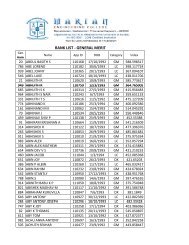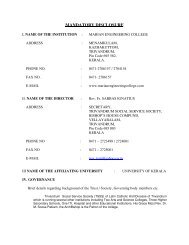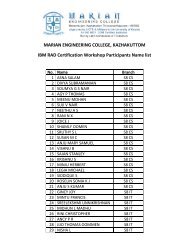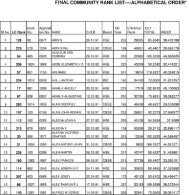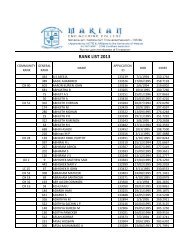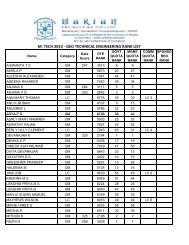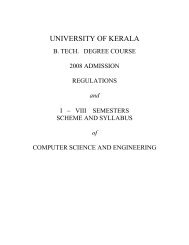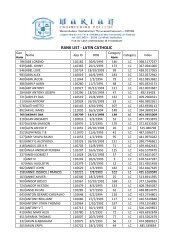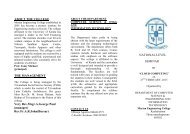UNIVERSITY OF KERALA - College of Engineering, Trivandrum
UNIVERSITY OF KERALA - College of Engineering, Trivandrum
UNIVERSITY OF KERALA - College of Engineering, Trivandrum
Create successful ePaper yourself
Turn your PDF publications into a flip-book with our unique Google optimized e-Paper software.
08.703 GEOTECHNICAL ENGINEERING-II L T P/D Cr<br />
3 1 0 4<br />
Module I<br />
Stresses in soil due to loaded areas - Boussinesq’s and Westergaard’s formulae for point loads – assumptions<br />
[no derivation required] – Comments - Vertical stress beneath loaded areas <strong>of</strong> strip, rectangular and circular<br />
shapes - Newmark’s charts - Isobars - Pressure bulbs<br />
Earth pressure – At-rest, active and passive earth pressures – Practical examples - Rankine’s and Coulomb’<br />
methods - Comparison[no derivation required] - Influence <strong>of</strong> surcharge, inclined backfill and water table on<br />
earth pressure - Earth pressure on layered soils<br />
ModuleII<br />
Bearing capacity <strong>of</strong> shallow foundations – Ultimate, safe and allowable bearing capacity. - Terzaghi’s<br />
formula[no derivation required] for isolated strip, circular and square footings - Bearing capacity factors - Local<br />
and general shear failure - Factors affecting bearing capacity – Influence <strong>of</strong> water table<br />
Settlement - Total and differential settlement - Causes - Methods <strong>of</strong> reducing differential settlement - Soil<br />
improvement through installation <strong>of</strong> vertical drains and preloading - Use <strong>of</strong> compaction piles<br />
Brief introduction to site investigation – Guidelines for choosing spacing and depth <strong>of</strong> borings [brief discussion<br />
only] - Auger boring and wash boring methods - Standard Penetration Test- - Soil investigation report<br />
ModuleIII<br />
Combined footings- Rectangular and Trapezoidal combined footings – Raft foundations - Allowable Bearing<br />
capacity <strong>of</strong> Rafts on sands and clays - Floating foundation.<br />
Pile foundations - Point bearing and friction piles - Bearing capacity <strong>of</strong> single pile in clay and sand[I.S. Static<br />
formulae] - Dynamic formulae(ENR and Modified Hiley only) - I.S. Pile load test [conventional]- Negative skin<br />
friction. on a single pile - Capacity <strong>of</strong> Pile groups - Group action<br />
Brief introduction to well foundations - Elements <strong>of</strong> a well foundation – Problems encountered in well sinking<br />
– Methods to rectify tilts and shifts - Brief introduction to Machine foundation –Mass spring model for<br />
undamped free vibrations - Natural frequency <strong>of</strong> foundation-soil system – Coefficient <strong>of</strong> uniform elastic<br />
compression – Methods <strong>of</strong> vibration isolation<br />
References:<br />
1. Gopal Ranjan & A.S.R Rao ,Basic and Applied Soil Mechanics , New Age International (P) Limited,<br />
New Delhi, 2002<br />
2. K.R. Arora ,Geotechnical <strong>Engineering</strong> , Standard Publishers Distributors, New Delhi, 2006<br />
3.Venkatramaiah,Geotechnical<strong>Engineering</strong>, Universities Press (India) Limited,Hyderabad, 2000<br />
4. Peck ,Hansen and Thornborn ,Foundation <strong>Engineering</strong> ,John Wiley & Sons, New York, 1947<br />
5. W.E.Teng, Foundation Design, Prentice Hall , New Jersey, 1962<br />
6. P.Purushothamaraj, Soil Mechanics and Foundation <strong>Engineering</strong>,Pearson Education, Delhi, 2008<br />
Question Paper: Duration:3 hours<br />
The question paper consists <strong>of</strong> Part A and Part B.<br />
Part A carries 40 marks. There will be 8 compulsory short answer questions covering entire syllabus.<br />
Part B is for 60 marks. There will be 2 questions from each module. The candidate has to answer one question<br />
<strong>of</strong> 20 marks from each module.<br />
74



